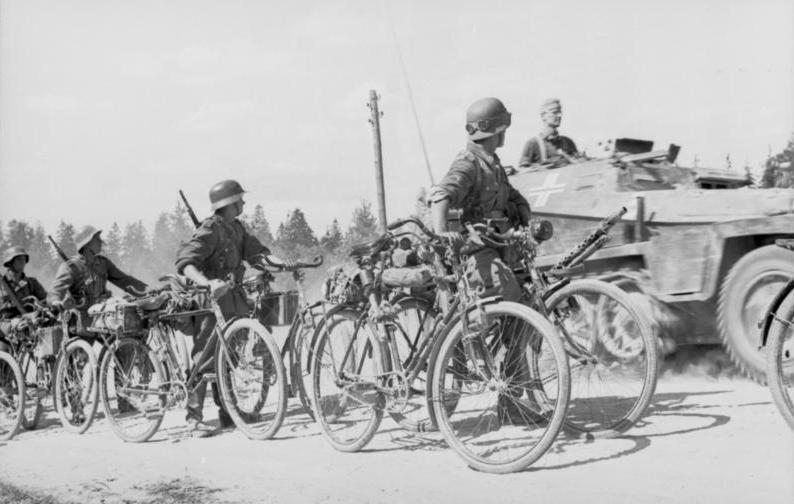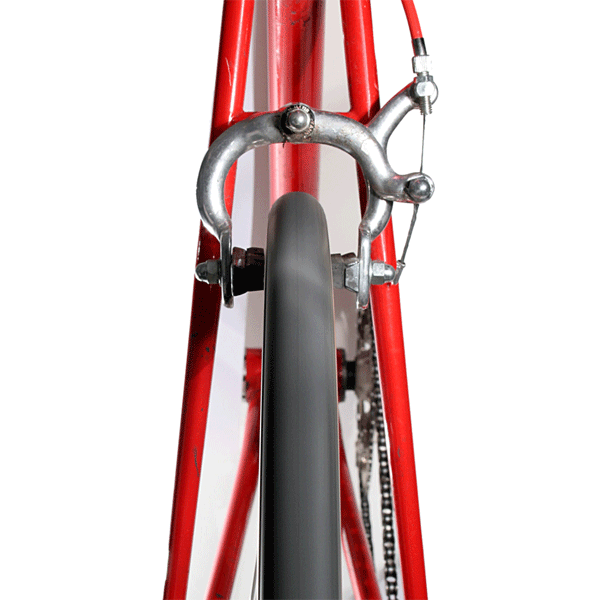|
Military Bicycle
A military bicycle is a bicycle specially adapted to the needs of armed forces. In use since the early 20th century in many armies throughout the world, bicycles allow for silent movement and increased mobility on the battlefield. Additional advantages of military bicycles are that they allow individual soldiers to carry more supplies without being encumbered and are very inexpensive to manufacture and maintain when compared to horses and vehicles. The first bicycles were introduced into the armed forces of several nations in the late 19th century; by the time of the start of World War I, all combatants were using them. The German Army had 36 independent companies of bicycle infantry, a battalion of cyclists attached to every cavalry division, and an additional 10 reserve bicycle companies and 17 replacement crews. The Italian Army's Bersaglieri troops were the first to use folding bikes. During World War II bicycles were introduced to paratroopers as a means to provide them with ... [...More Info...] [...Related Items...] OR: [Wikipedia] [Google] [Baidu] |
Paratrooper
A paratrooper is a military parachutist—someone trained to parachute into a military operation, and usually functioning as part of an airborne force. Military parachutists (troops) and parachutes were first used on a large scale during World War II for troop distribution and transportation. Paratroopers are often used in surprise attacks, to seize strategic objectives such as airfields or bridges. Overview Paratroopers jump out of airplanes and use parachutes to land safely on the ground. This is one of the three types of "forced entry" strategic techniques for entering a theater of war; the other two being by land and by water. Their tactical advantage of entering the battlefield from the air is that they can attack areas not directly accessible by other transport. The ability of air assault to enter the battlefield from any location allows paratroopers to evade emplaced fortifications that guard from attack from a specific direction. The possible use of paratrooper ... [...More Info...] [...Related Items...] OR: [Wikipedia] [Google] [Baidu] |
M42 Truppenfahrrad
The M42 Truppenfahrrad was a military bicycle issued to the Heer and Waffen SS during World War II. Special equipment for military use was: the steering bar, the saddle, the toolbox (which could be fitted with two grenades) and the porter at the back. On the steering bar were holders mounted for holding a variety of items, such as a half-shelter tent, clothing, and panzerfausts. The mid-section could be fitted to hold machineguns. The headlamp was made to work with dynamo and/or battery. Numerous units of the German ground forces were equipped with bicycles. In addition to aiding troops in their movement, they were also used to deliver mail and maintain connections between a general A general officer is an Officer (armed forces), officer of highest military ranks, high rank in the army, armies, and in some nations' air forces, space forces, and marines or naval infantry. In some usages the term "general officer" refers t ... and his troops, and for other purposes. ... [...More Info...] [...Related Items...] OR: [Wikipedia] [Google] [Baidu] |
Swiss Army Bicycle
The Swiss Army Bicycle (also known as Armeefahrrad - Militärvelo - Militaervelo - Militärfahrrad - vélo militaire - bicicletta militare), the M0-5, and later the MO-93, was utilized by the Swiss Army from 1905 until the mid-1990s. In 2012 a new, lighter MO-12 or Fahrrad 12 (bicycle 12) was procured. The MO-05 The classic Swiss Army Bicycle, as used by the Swiss Bicycle infantry, Bicycle Infantry. Officially called Ordonnanzfahrrad Modell 05, it was introduced in 1905 and in continuous use until replaced by the MO-93. It was built between 1905 and 1989 by Schwalbe, Cäsar, Cosmos, Mondia and Condor. Swiss bicycle Infantry were phased out in 2001. The most recognisable feature of most Swiss Army Bicycles is the large carry case fitted into the frame. It is accessed from the right-hand side, whilst having a separate document and map compartment on the left-hand side. They were painted all-over basic black, usually semi-matt, although some later models were painted olive drab. Fi ... [...More Info...] [...Related Items...] OR: [Wikipedia] [Google] [Baidu] |
Swedish Military Bicycle
Swedish military bicycles ( sv, militärcykel), or Swedish army bicycles, have been used in the Swedish military for over a century. History The first bicycles in the Swedish military were privately owned or bought for testing purposes. Bicycle infantry were first introduced in 1901, when the Gotland Infantry Regiment (I 27) in Visby, replaced its cavalry complement with bicycle-mounted troops. By 1942, there were six bicycle infantry regiments in the Swedish Army, operating mainly m/30s and m/42s. However, there were also examples of undesignated tandem bicycles for use by field radio operators and specially fitted pairs of bicycles designed for mounting a stretcher between the lead's rack and the rear's steer tube. Following World War II, in 1947, the decision was made to decommission the bicycle infantry regiments. They were gradually removed from the Army between 1948 and 1952. Following this decision, the role of the bicycle shifted away from a combat one to a more util ... [...More Info...] [...Related Items...] OR: [Wikipedia] [Google] [Baidu] |
Outline Of Cycling
:''This article is an outline about the activity of cycling. For an outline about bicycles themselves, see outline of bicycles.'' :The following ''outline'' is provided as an overview of, as well as a topical guide to cycling: Cycling, also called bicycling or biking, is the activity of using / riding bicycles, (at least partially) human-powered, wheeled vehicles (typically by foot pedalling), for purposes including transport, recreation, social interaction, exercise, sport, therapy, other purposes, or any combination thereof. Persons engaged in cycling are called cyclists, bikers, or sometimes bicyclists. They typically either dress for where they are going, or for the cycling, sometimes having another set of clothing with them, or arranged. Apart from regular two-wheeled bicycles, cycling also includes riding unicycles, tricycles, quadricycles, and other similar human-powered wheeled vehicles (HPVs). Some bicycles are sold with (electric) motors (e-bikes), or ot ... [...More Info...] [...Related Items...] OR: [Wikipedia] [Google] [Baidu] |
Bicycle Infantry
Bicycle infantry are infantry soldiers who maneuver on (or, more often, between) battlefields using military bicycles. The term dates from the late 19th century, when the "safety bicycle" became popular in Europe, the United States, and Australia. Historically, bicycles lessened the need for horses, fuel and vehicle maintenance. Though their use has waned over the years in many armies, they continue to be used in unconventional armies such as militias. History Origins The development of pneumatic tires coupled with shorter, sturdier frames during the late 19th century led to the investigation of possible military uses for bicycles. To some extent, bicyclists took over the functions of dragoons, especially as messengers and scouts, substituting for horses in warfare. Bicycle units or detachments were in existence by the end of the 19th century in most armies. The United Kingdom employed bicycle troops in militia or territorial units, rather than in regular units. Essen ... [...More Info...] [...Related Items...] OR: [Wikipedia] [Google] [Baidu] |
Electric Bicycles
An electric bicycle (e-bike, eBike, etc.) is a motorized bicycle with an integrated electric motor used to assist propulsion. Many kinds of e-bikes are available worldwide, but they generally fall into two broad categories: bikes that assist the rider's pedal-power (i.e. pedelecs) and bikes that add a throttle, integrating moped-style functionality. Both retain the ability to be pedaled by the rider and are therefore not electric motorcycles. E-bikes use rechargeable batteries and typically are motor-powered up to . High-powered varieties can often travel more than . E-bike use is growing in some markets, as they are seen as an eco-friendly and healthy alternative to cars, fossil fuel-powered mopeds and small motorcycles, and a less physically intense alternative to conventional bicycles. Depending on local laws, many e-bikes (e.g., ''pedelecs'') are legally classified as bicycles rather than mopeds or motorcycles. This exempts them from the more stringent laws regarding th ... [...More Info...] [...Related Items...] OR: [Wikipedia] [Google] [Baidu] |
Cyclocomputer
A cyclocomputer, cycle computer, cycling computer or cyclometer is a device mounted on a bicycle that calculates and displays trip information, similar to the instruments in the dashboard of a car. The computer with display, or ''head unit'', usually is attached to the handlebar for easy viewing. Some GPS watches can also be used as display. History In 1895, Curtis H. Veeder invented the ''Cyclometer''. The Cyclometer was a simple mechanical device that counted the number of rotations of a bicycle wheel. A cable transmitted the number of rotations of the wheel to an analog odometer visible to the rider, which converted the wheel rotations into the number of miles traveled according to a predetermined formula. After founding the Veeder Manufacturing Company, Veeder promoted the Cyclometer with the slogan, ''It's Nice to Know How Far You Go''. The ''Cyclometers success led to many other competing types of mechanical computing devices. Eventually, cyclometers were developed ... [...More Info...] [...Related Items...] OR: [Wikipedia] [Google] [Baidu] |
Bicycle Brake
A bicycle brake reduces the speed of a bicycle or prevents it from moving. The three main types are: rim brakes, disc brakes, and drum brakes. Most bicycle brake systems consist of three main components: a mechanism for the rider to apply the brakes, such as brake levers or pedals; a mechanism for transmitting that signal, such as Bowden cables, hydraulic hoses, rods, or the bicycle chain; and the brake mechanism itself, a caliper or drum, to press two or more surfaces together in order to convert, via friction, kinetic energy of the bike and rider into thermal energy to be dissipated. History Karl Drais included a pivoting brake shoe that could be pressed against the rear iron tyre of his 1817 . This was continued on the earliest bicycles with pedals, such as the boneshaker, which were fitted with a spoon brake to press onto the rear wheel. The brake was operated by a lever or by a cord connecting to the handlebars. The rider could also slow down by resisting the pedals ... [...More Info...] [...Related Items...] OR: [Wikipedia] [Google] [Baidu] |



.jpeg)


